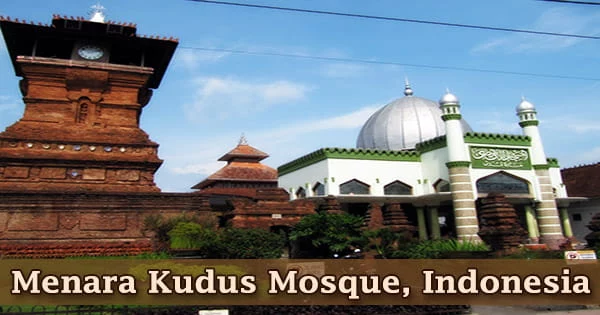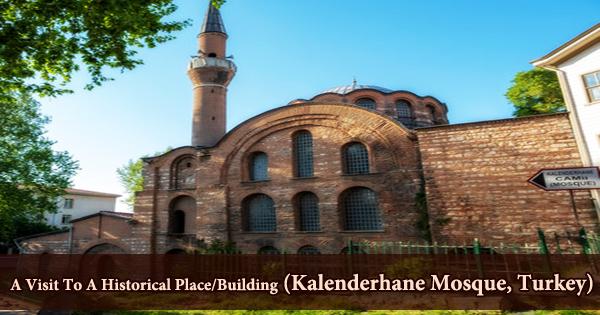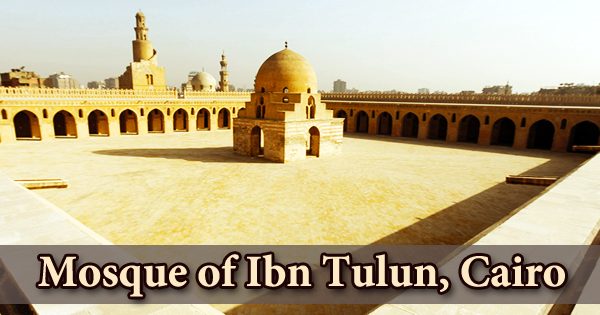The Menara Kudus Mosque, also known as the Al-Aqsha Mosque, is located in Kudus, Indonesia’s Central Java region. The oldest example of a Javanese minaret may be found in the Masjid Menara (Minaret Mosque) in Kudus. The syncratization of Hindu-Javanese design and Islamic function is notable in this early sixteenth-century minaret. It is one of Indonesia’s earliest mosques, dating from 1549, and was constructed during the expansion of Islam throughout Java. The grave of Sunan Kudus, one of Java’s nine Islamic saints (the Wali Sanga), is preserved in the mosque, which is a major pilgrimage site. The 20-meter-high square brick tower is reminiscent of fortified Hindu temples’ watchtowers, or kukuls, as well as the chandi, an East Javanese sepulchral monument made of volcanic rock. The tiered brick construction is approached by a split gateway, or chandi bentar, and climbs to a wooden pavilion, which houses the bedug and kentongan. The drum used to summon Muslims to prayer, the bedug, is elevated above ground level in a serambi, or covered open space, which is unusual. The kentongan is a hollowed wooden instrument that vibrates when hit and is also used to call for prayers. Visitors from all around the world, not just Indonesians, are welcome. The grave of Sunan Kudus is also located in the mosque area, and pilgrims gather here to worship. Masjid Menara Kudus is a mosque in Kauman village, Kota, Kudus Regency, Indonesia. According to its history, it was built as Masjid Al-Aqsa in 956 Hijriyah or 1549, the same year as one of Palestina’s mosques. The mosque was called Al Aqsa mosque when Ja’fat Sodiq, subsequently known as Sunan Kudus, acquired a souvenir stone from Baitul Maqdis in Palestina, which was set as the first stone on the building construction. For its Hindu Majapahit tower on the east side of the mosque, this mosque is now known as Menara (Tower) Kudus.

Old Javanese split entrances, ancient Hindu-Buddhist inspired Majapahit-style red brickwork, and a three-tired pyramidal roof are among the mosque’s pre-Islamic architectural features. The brick minaret, atop which a pavilion houses a big skin drum (bedug) that is used to summon the faithful to prayer instead of the more frequent muezzin, is the most distinctive feature. An overlapping hipped roof structure covers the top of the minaret, emphasizing the tower’s verticality. This roof design, which is supposed to mimic the Hindu mountain meru, allows air to move between the strata of the roof. The meru roof is a popular form of roof in Javanese mosques, and the next mosque has one as well. This sort of roof is supported by an open-timbered beam construction of concentric squares, with four outside beams supporting the lower roof and four concentrated interior beams supporting the higher roof. This saka guru method may also be utilized to many hipped roofs. When Islam first arrived in Indonesia, missionaries wisely used Indonesian culture to introduce the holy Koran, ensuring that religion and culture swiftly mixed and developed. This mosque is one of a kind; no other mosque in the world has architecture like it. Walls and gateways in the traditional candi bentar (split gate) and kori agung (major gate) styles surround the minaret and the compound. Inside, there are two gates: a smaller inner gate with relief panels on either side, similar to those found at Mantingan, and an exterior gate that looks like the Bajang Ratu gate at Trowulan from the 14th century. Despite the fact that the mosque that the minaret serves was recently restored, the mosque complex’s layout remains unchanged. The mosque, as well as the adjacent walled courtyards, are oriented east to west. The complex is divided into multiple inner courts, including candi bentar, a split-gate that provides entry to the inner sanctuary, and kori agung, a gate with both a roof and a door, connecting one court to the next. In the mosque, there are two ceramics that were manufactured in Vietnam. The first ceramic is on the north entry, in the shape of a square, with a white base color and a floral motif in blue hue in the centre. This porcelain is said to have been created in the 14th or 15th centuries. The other is on the southern entry, larger in size and dominated by blue floral patterns; it is said to have been made in the 15th century and has an Islam design that is prevalent in Istambul. The pre-Islamic components indicate that the complex was built on top of a Hindu-Javanese building. The minaret is inlaid with blue and white pottery plates that were added in the eighteenth or nineteenth centuries, in addition to Arabic and Javanese inscriptions. The clock atop the west façade and the “Allah” sign, which shines neon at night, are further recent additions. The first mosque, erected in 1549, was called Aqsa by Jafar Shodiq, one of the nine walis, or saints, who are claimed to have propagated Islam throughout Java, according to an inscription above the mihrab within the mosque.
















